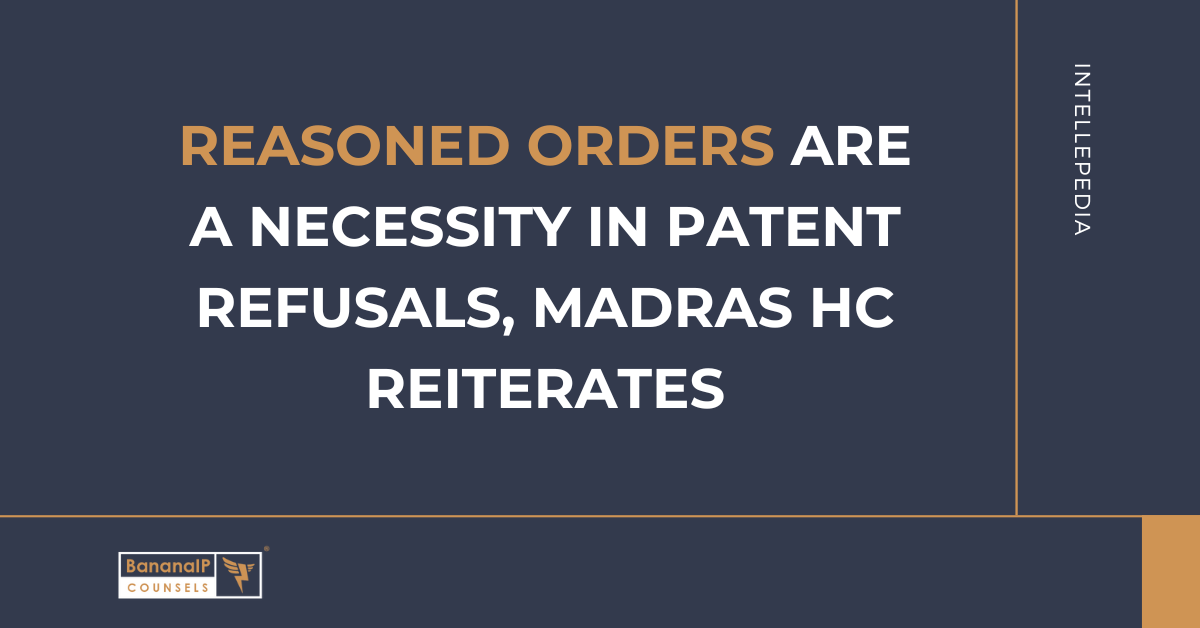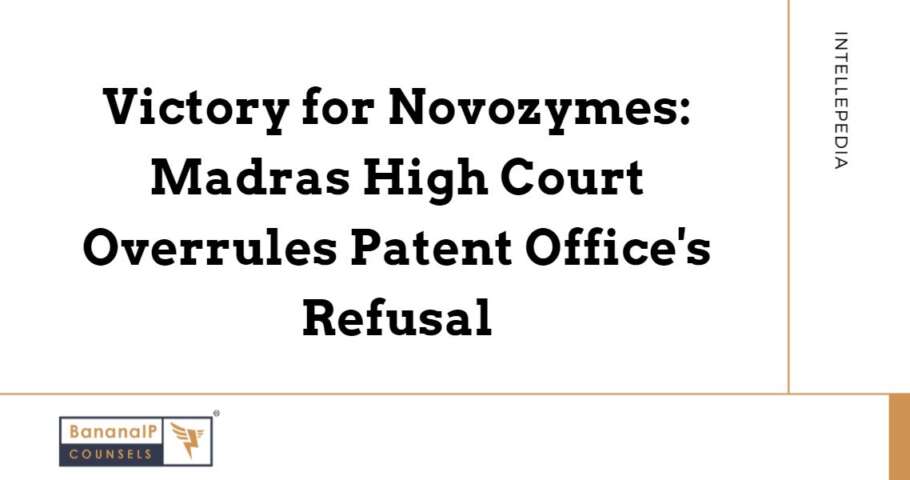Indian courts have recently adopted a firm stance against unreasoned patent refusal orders. In a notable instance, in Signal Pharmaceuticals vs. Deputy Controller of Patents, the Madras High Court annulled an unsubstantiated refusal order issued by the Patent Office and remanded the case for reconsideration.
Background
The patent application titled “mTOR Kinase Inhibitors for Oncology Indications and Diseases Associated with the mTOR/PI3K/AKT Pathway”, filed by Signal Pharmaceuticals (“Signal”), claimed heteroaryl compounds and their pharmaceutically acceptable derivatives with demonstrated utility in cancer detection. However, in the impugned order dated 17th May 2019, the Deputy Controller of Patents (“Controller”) refused the application, citing a lack of inventive step under Section 2(1)(ja) and non-patentability under Section 3(d) of the Patents Act, 1970.
Arguments by the parties
Signal challenged the refusal order, asserting that the Controller’s order was a non-speaking order and violated legal principles on uniqueness and inventiveness. They argued that their submissions detailing inventive features, biological activity and technical advancement of the invention over cited prior art (D1) were ignored. Signal also contended that the amended claims, which addressed the objections in the First Examination Report (FER), were overlooked, and the grounds of lack of inventive step and non-patentability were improperly raised. Furthermore, they claimed that the Controller failed to recognize the clear gap between the amended claims and prior art.
Signal emphasized that the core structure of their claimed compounds is distinct from prior art. Signal also contended that the Controller disregarded the expert affidavit dated 19th March 2019, which substantiated the enhanced therapeutic efficacy of the invention. They alleged that the Controller refused the patent without providing proper reasoning as to why the invention did not meet the test of therapeutic efficacy.
The counsel for the Controller defended the rejection, asserting that the decision was justified and did not warrant judicial interference. He argued that the appellant failed to provide evidence proving the distinctiveness of their invention from prior art. Additionally, he maintained that the invention lacked technical advancement and was rightly excluded from patentability under Section 3(d) of the Patents Act.
Court’s Observations
The Court observed that, upon prima facie review, the impugned order showed that the Controller overlooked the clear gap between the amended claims and prior art. The Court noted that the order lacked detailed reasoning and failed to analyse the distinctions between the appellant’s claims and prior art. The Court highlighted that the core structure of the claimed invention as well as prior document are different and no proper reasoning was provided by the Controller to conclude that D1 was similar to Signal’s invention. The Court also found that the Controller disregarded Signal’s written submissions, responses to the First Examination Report (FER), and amended claims, resulting in a significant procedural lapse. Despite evidence supporting therapeutic efficacy, the Controller did not explain why the claimed invention failed to meet the test of therapeutic efficacy. Citing precedents such as Avery Dennison Corporation v. Controller of Patents and Blackberry Ltd. v. Assistant Controller of Patents, the Court emphasized that patent refusals must be supported by reasoned orders that fully address the applicant’s arguments.
Conclusion
The Court quashed the impugned order and remanded the matter for fresh consideration by a different officer. The Court emphasized that the new officer must adhere to the Court’s observations, and issue a new order within six months from the receipt of the judgment. In light of the growing concerns from the Courts regarding unreasoned orders, it is pivotal for the Patent Office to enhance its performance and align more closely with the expectations entrusted to it.
Relevant paragraphs
- This Court has carefully analyzed the evidence available on record before the respondent. The appellant has placed several documents in support of their invention and they have also submitted explanation to the queries raised by the respondent in the FER. They have also filed their written arguments and amended claims to comply with the objections raised by the respondent in the FER. A categorical assertion has also been made by the appellant that their invention is a technical advancement, which may satisfy the inventive step requirement of Section 2(1)(ja) of the Act. The learned counsel for the appellant also drew the attention of this Court to the core structure of the appellant’s invention and would point out that the core structure of the appellant’s invention is different from the prior art document (D1), which discloses the core structure of the known substance.
- On a prima-facie consideration of the impugned order, it is seen that the respondent has ignored the clear gap between the amended claims and the prior art document. The written submissions of the appellant has not been considered by the respondent under the impugned order. The appellant had also filed responses to the objections raised by the respondent with regard to the inventive step requirement as per Section 2(1)(ja) of the Patents Act; and the appellant had also filed amended claims; but, as seen from the impugned order, the respondent erred in not giving sufficient reasons for rejecting the appellant’s amended claims.
- As seen from the decision relied upon by the learned counsel for the appellant in Avery Dennison Corporation (cited supra), the Delhi High Court has held that a significant technical advancement is sufficient to satisfy inventive step required under Section 2(1)(ja) of the Patents Act. The core structure of the appellant’s claimed invention as well as prior document (D1) seem to be different and no proper reasoning have been given for the purpose of coming to the conclusion that prior document (D1) is similar to the core structure of the appellant’s invention. The appellant has categorically contended that the appellant’s invention has significant technical elements than that of the prior art and therefore, there is inventive step in the appellant’s invention. https://www.mhc.tn.gov.in/judis
- This Court, after careful perusal of the impugned order, is of the considered view that no sufficient reasoning has been given by the respondent for coming to the conclusion that there is no inventive step in the appellant’s claimed invention. The Hon’ble Supreme Court in the case of Novartis AG (cited supra) has also made it clear that in the case of a medicine that claims to cure a disease, the test of efficacy can only be therapeutic efficacy. But, however, as seen from the impugned order, the respondent has not given any reason as to why the appellant’s claimed invention does not satisfy the test of therapeutic efficacy. The prior art document (D1), on a prima-facie consideration, is primarily with respect to compounds containing a fused 5-membered ring disclosed in Table 1 of D1, as opposed to R1 (appellant’s invention), that is, heterocyclyl with pyrazino pyrazine core. However, as seen from the impugned order, the prior art document (D1) as well as the appellant’s invention (R1) have not been properly analyzed and there is no proper reasoning given for coming to the conclusion that the core structure of R1 and the core structure of D1 are one and the same.
- It is settled law, as laid down by various decisions including the decision of the Delhi High Court in Blackberry (cited supra), that unreasoned orders (non-speaking orders) cannot be passed by the Controller of Patents and the Controller should not merely reproduce the objections made during FER while refusing to grant patent. Only through a speaking order by giving proper reasons as to why the applicant’s contentions has to be rejected, a patent application can be rejected.
- In the case on hand, as seen from the impugned order, there is no proper appreciation of evidence by the respondent. The respondent seems to have ignored the gap between the amended claims and the prior art; and has not given reasons as to why the amended claims and the prior art are one and the same; and the respondent has also ignored the legal principles rendered by the Constitutional Courts on uniqueness and inventiveness. While passing the impugned order, the respondent has also not considered the written submissions of the appellant; responses to objections raised by the respondent; and the amended claims of the appellant in compliance to objections raised by the respondent. Through a non-speaking order, the respondent under the impugned order has refused to grant patent to the appellant on the ground of lack of inventive step over the prior art and that the claims are non-patentable under Section 3(d) of the Patents Act.
Citation: Signal Pharmaceuticals v. Deputy controller of Patent & Designs, (T)C.M.A(PT).No.145 of 2023, Madras High Court, Available at: https://indiankanoon.org/doc/88846321/
Authored by Dr. Neetha Mohan, Patents Team, BananaIP Counsels
Disclaimer
The case note/s in this blog post have been written by IP Attorneys at BananaIP Counsels based on their review and understanding of the Judgments. It may be noted that other IP attorneys and experts in the field may have different opinions about the cases or arrive at different conclusions therefrom. It is advisable to read the Judgments before making any decisions based on the case notes.
If you have any questions, or if you wish to speak with an IP expert/attorney, please reach us at: contact@bananaip.com or 91-80-26860414/24/34.



